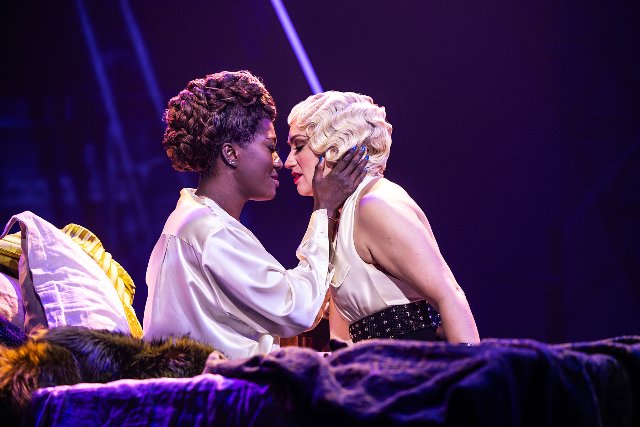Lempicka Bombs on Broadway
An interesting Artist but Muddled Production
By: Charles Giuliano - Apr 26, 2024
Why did the creators (Carson Kreitzer and Matt Gould) of Lempicka make the choices they did?
The new original musical, Lempicka had me thinking about that. It is that rarity on Broadway — it was not a play, a book, a story, a movie, a concept album or anything else before it was a musical.
First of all – the title. What does the title refer to?
It isn’t a what but a who: the title refers to Tamara de Lempicka, a Polish artist of the early 20th century who was well-known at the time for her portraits of socialites and kings and stylized nudes. Some of her work combined art deco and industrialism while others were influenced by cubism. Though she fell out of favor in the mid-20th century, in the 21st century, more attention has been paid, and many celebrities collect her work.
Why did they feel the need to invent so much, when her real life story was fascinating. It may have had some conventional elements, but Kreitzer and Gould made them even more common in these types of stories. Though Jewish, she marries a Polish aristocrat(Tadeusz) in St. Petersburg; the Russian Revolution erupts and he is arrested; she does “anything” to get him out; they settle in Paris, where she returns to drawing and painting. She endlessly paints her daughter. He can’t adjust to having to work, so she becomes the breadwinner. She first sells her works along the Seine and later in shows.
As the Nazis are gaining power, Tadeuz want to return to Poland; Lempicka, who is Jewish, leaves Paris for the US.
It is interesting but hardly unique. After some research, I found her actual life more interesting than some of the invented incidents in the musical. She painted royalty, was brought to the US in the ‘20s to paint a society portrait and had an exhibition of her works. Her work was regularly on the covers of fashion magazines.
This could be described as the story of a very determined woman who emotionally was either stunted or cold, who put her own interests above anything or anyone else. At times, she reminded me of Evita; to add to that, both were blonds. In fact, the musical has created a Che-like character, the Italian painter Mainetti. If Che was cynical and a socialist, Marinetti is foul-mouthed and a Fascist.
Kreitzer and Gould did leave in Suzy Solidor, who was in Lempicka’s circle of lesbian friends. A good decision was to take one of Lepicka’s lovers, Rafeala, stand in for all of them.
What stands out in this production is the scenic design by Riccardo Hernández; it features reproductions of her works and captures the Art Deco style 20s and 30s. You will also appreciate the costume design by Paloma Young and the lighting by Bradley King.
From the beginning—showing an elderly Lempicka supposedly sitting at a table in Los Angeles—to the end, which returns to that scene, the show needed serious editing. They have added real people or created composite characters that add little to understanding her or her life.
Eden Espinoza has the difficult job of making this all work. She isn’t helped that the score requires so much high belting, that at times she is flat. How will her voice stand up to eight performances a week?
Only a few songs stood out; “Just This Way” which is sung by a minor character, though played by the spending but underused Beth Leavel, and two songs that Taduesz sings – “Wake Up” and “What She Sees.” Most of the others blend together.
Espinoza does what she can with the role which never explains why Lempicka seems so aware of political threats. Andrew Samonsky is equally burdened in the underwritten and undermotivated role of Tadeuz. Amber Iman plays Rafela with show biz panache and more belting.
All in all, Lempicka was an interesting woman; this show does not do her or the cast justice.

